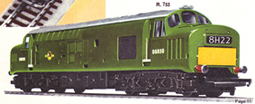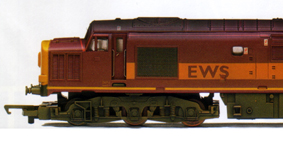Locomotive Class
Class 37 (Type 3)
 Class: Class 37 (Type 3)
Class: Class 37 (Type 3)
Type: Diesel-Electric
Designer: English Electric Company
Weight: 105 tons
Purpose: Heavy Freight & Passenger
Information: Nicknamed ďtractorsĒ due to their distinctive exhaust sound the all-purpose diesel-electric Type 3 / Class 37 locomotive were conceived as part of the British Railways Modernisation Plan. These versatile machines were introduced to the Eastern Region in 1960. Members of the class eventually saw service in many capacities from humble freights to inter-regional express passenger primarily on the Eastern Region, Western Region, and in Scotland. Although vastly reduced in numbers, variants of the class were still operational in 2010.
Details: Arguably the most versatile diesel-electric designs associated with the Modernisation Plan, the Type 3 Co-Co locomotive was introduced for passenger and freight service in 1960. As to why Type 3 power class rating was needed at the time is a bit of a mystery; the fact remains that after only a few years of service the Type 3 ousted many of the Type 2 designs. There-in became the success of the Class 37.
Re-classified Class 37 under the TOPS numbering scheme; eventually 309 locomotives were built in various batches between 1960 and 1965 under the direction of English Electric Company at the Vulcan Foundry and Robert Stephenson and Hawthorns company works.
Although initial batches were destined for Eastern Region workings the versatility, loading gauge, and availability enabled their usage through-out Britain. However, the intent of Inter-Regional operations never materialized and as such the class was found primarily on Eastern and Western Region metals wide-spread through-out England, Wales, and Scotland.
The English Electric V-12 engine was capable of 2,000-BHP providing good acceleration and speed for passenger train operation. The design was capable of a top speed of 90-MPH top speed. Modifications and trials performed by Western Region on express passenger services between London and Bristol proved successfully that they could be operated in excess of 100-MPH through double heading. However, the operational costs of running two locomotives and fact that the larger Type 4 / Class 47 design was available for these services relegated the Class 37 to their intended purpose.
The majority of the class was fitted from new with steam heating for passenger coach operation. Later production units were not all so fitted, as many were now being allocated to heavy freight usage in the coal fields of South Wales.
By the late 70ís and early 80ís much of the older Mark 1 passenger fleet was removed from service, being replaced by modern equipment not requiring the steam boilers. At this time boilers were removed and members of the class found a new existence in freight hauling on local lines; replacing redundant first generation diesels that had not proven as successful as the 37ís.
Although continual rebuilding and alterations had been made, by the 1990ís the class was being with-drawn primarily due to age and changes to the railway infrastructure itself. The need for multi-purpose designs was no longer of importance and newer dedicated machines such as the GM Class 66 were being introduced in large numbers. Days of the local pick-up goods train was long gone and Inter-Regional passenger services were being relegated to modern DMU or EMU coaching sets.
Originally out-shopped in British Railways solid green with grey roofs; due to their long life spans class members have seen a wide variety of liveries, too numerous to mention. The class is commonly associated with BR corporate blue with yellow ends as seen through the 70ís; but by the mid 1980ís Regional and Operational Sectorization saw the class take on a variety of liveries and variations. This was further complicated by the infusion of Private Operator liveries applied from the mid 1990ís with many members being repainted yearly, as they were transferred between various companies and services.
Through the 2000ís members of the class have still found favour with private operators for specific purposes; such as the spot-hire companies and maintenance service. In addition many have been taken into preservation as their versatility and popularity have ensured their existence for many years to come.
John Faulkner
Class 37 (Type 3) Releases (27)
Class 37 (Type 3) Images (27)

Class 37 (Type 3) Co-Co Locomotive 37130

Class 37 (Type 3) Co-Co Locomotive D6830

Class 37 (Type 3) Co-Co Locomotive 37073

Class 37 (Type 3) Co-Co Locomotive D6830

Class 37 Co-Co Diesel Electric Locomotive 37885

Class 37 Co-Co Diesel Electric Locomotive 37424

Class 37 Co-Co Diesel Electric Locomotive 37***

Class 37 Co-Co Diesel Electric Locomotive 37042

Class 37 Co-Co Diesel Electric Locomotive D6700

Class 37 Co-Co Diesel Electric Locomotive D6704

Class 37 Co-Co Diesel Electric Locomotive - Aluminium 100 (Weathered) 37410

Class 37 Co-Co Diesel Electric Locomotive - Caithness 37261

Class 37 Co-Co Diesel Electric Locomotive - Radio Highland 37260

Class 37 Co-Co Locomotive - Railfreight 37518

Class 37 Diesel Electric Locomotive 37371

Class 37 Diesel Electric Locomotive 37427

Class 37 Diesel Electric Locomotive 37038

Class 37 Diesel Electric Locomotive (Multiple Working) (Weathered) 37405 37416

Class 37 Diesel Electric Locomotive (Multiple Working) (Weathered) 37174 37298

Class 37 Diesel Electric Locomotive - Midland Railway Centre (Multiple Working) (Weathered) 37216 37248

Class 37 Diesel Locomotive 37063

Class 37 Diesel Locomotive D6736

Class 37 Diesel Locomotive D6721

Class 37 Diesel Locomotive 37202

Class 37 Diesel Locomotive 37414

Class 37 Diesel Locomotive - William Cooksworthy 37207

Class 37 Locomotive 37071

















